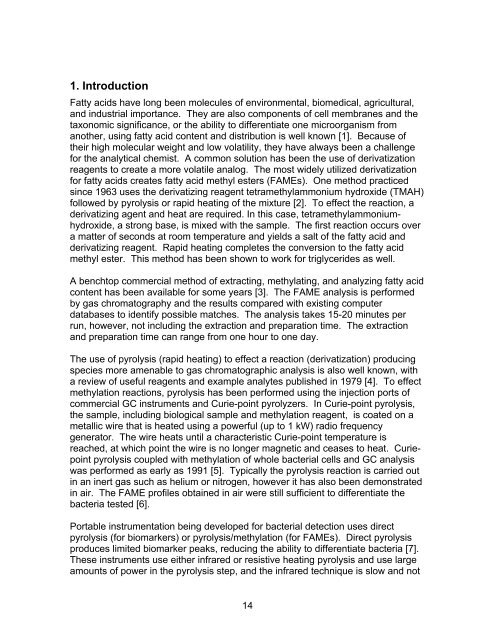Miniature Sensors for Biological Warfare Agents using Fatty Acid ...
Miniature Sensors for Biological Warfare Agents using Fatty Acid ...
Miniature Sensors for Biological Warfare Agents using Fatty Acid ...
You also want an ePaper? Increase the reach of your titles
YUMPU automatically turns print PDFs into web optimized ePapers that Google loves.
1. Introduction<br />
<strong>Fatty</strong> acids have long been molecules of environmental, biomedical, agricultural,<br />
and industrial importance. They are also components of cell membranes and the<br />
taxonomic significance, or the ability to differentiate one microorganism from<br />
another, <strong>using</strong> fatty acid content and distribution is well known [1]. Because of<br />
their high molecular weight and low volatility, they have always been a challenge<br />
<strong>for</strong> the analytical chemist. A common solution has been the use of derivatization<br />
reagents to create a more volatile analog. The most widely utilized derivatization<br />
<strong>for</strong> fatty acids creates fatty acid methyl esters (FAMEs). One method practiced<br />
since 1963 uses the derivatizing reagent tetramethylammonium hydroxide (TMAH)<br />
followed by pyrolysis or rapid heating of the mixture [2]. To effect the reaction, a<br />
derivatizing agent and heat are required. In this case, tetramethylammoniumhydroxide,<br />
a strong base, is mixed with the sample. The first reaction occurs over<br />
a matter of seconds at room temperature and yields a salt of the fatty acid and<br />
derivatizing reagent. Rapid heating completes the conversion to the fatty acid<br />
methyl ester. This method has been shown to work <strong>for</strong> triglycerides as well.<br />
A benchtop commercial method of extracting, methylating, and analyzing fatty acid<br />
content has been available <strong>for</strong> some years [3]. The FAME analysis is per<strong>for</strong>med<br />
by gas chromatography and the results compared with existing computer<br />
databases to identify possible matches. The analysis takes 15-20 minutes per<br />
run, however, not including the extraction and preparation time. The extraction<br />
and preparation time can range from one hour to one day.<br />
The use of pyrolysis (rapid heating) to effect a reaction (derivatization) producing<br />
species more amenable to gas chromatographic analysis is also well known, with<br />
a review of useful reagents and example analytes published in 1979 [4]. To effect<br />
methylation reactions, pyrolysis has been per<strong>for</strong>med <strong>using</strong> the injection ports of<br />
commercial GC instruments and Curie-point pyrolyzers. In Curie-point pyrolysis,<br />
the sample, including biological sample and methylation reagent, is coated on a<br />
metallic wire that is heated <strong>using</strong> a powerful (up to 1 kW) radio frequency<br />
generator. The wire heats until a characteristic Curie-point temperature is<br />
reached, at which point the wire is no longer magnetic and ceases to heat. Curiepoint<br />
pyrolysis coupled with methylation of whole bacterial cells and GC analysis<br />
was per<strong>for</strong>med as early as 1991 [5]. Typically the pyrolysis reaction is carried out<br />
in an inert gas such as helium or nitrogen, however it has also been demonstrated<br />
in air. The FAME profiles obtained in air were still sufficient to differentiate the<br />
bacteria tested [6].<br />
Portable instrumentation being developed <strong>for</strong> bacterial detection uses direct<br />
pyrolysis (<strong>for</strong> biomarkers) or pyrolysis/methylation (<strong>for</strong> FAMEs). Direct pyrolysis<br />
produces limited biomarker peaks, reducing the ability to differentiate bacteria [7].<br />
These instruments use either infrared or resistive heating pyrolysis and use large<br />
amounts of power in the pyrolysis step, and the infrared technique is slow and not<br />
14
















